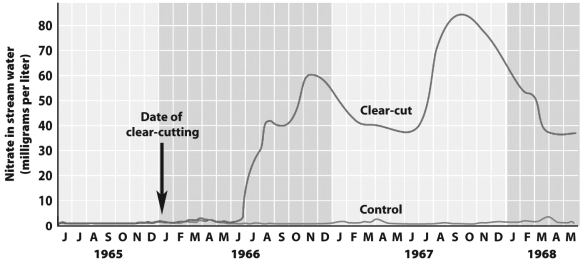In the Hubbard Brook Experimental Forest in New Hampshire, a portion of the forest was first clear-cut, then sprayed with herbicides for 3 years to prevent growth. A second portion of the forest was not clear-cut or sprayed and served as a control plot. The graph below shows that nitrate, a form of nitrogen that is important to plants, was lost from the ecosystem in streams at a much higher rate in the clear-cut portion of the forest than in the control portion. 
What best explains the small releases of nitrogen from the control portion of the forest at the Hubbarb Brook Experimental Forest?
A) Its nitrogen was sequestered in the forest biomass and temporarily unavailable.
B) With intact vegetation to intercept the acid rain that falls in the area it failed to reach the soil and chemically react to release the nitrogen.
C) With intact vegetation, rainwater washed little soil and nitrogen from the forest floor.
D) All of the above contributed to the small amount of nitrogen loss.
Correct Answer:
Verified
Q41: The amount of energy that organisms capture
Q45: Eventually,all biomass produced by any organism is
Q49: The rate of new biomass production by
Q50: A community of organisms,together with the chemical
Q52: In marine ecosystems the highest concentrations of
Q56: Human actions such as logging, building on
Q60: Phosphorus is the only major nutrient whose
Q60: Each level of an energy pyramid corresponds
Q71: An atom of phosphorous may remain out
Q75: Energy cannot be recycled.
Unlock this Answer For Free Now!
View this answer and more for free by performing one of the following actions

Scan the QR code to install the App and get 2 free unlocks

Unlock quizzes for free by uploading documents